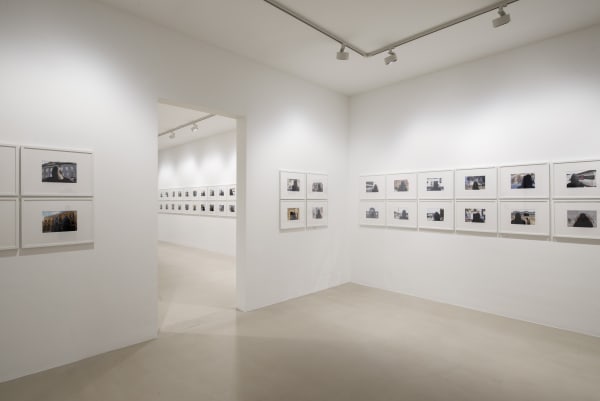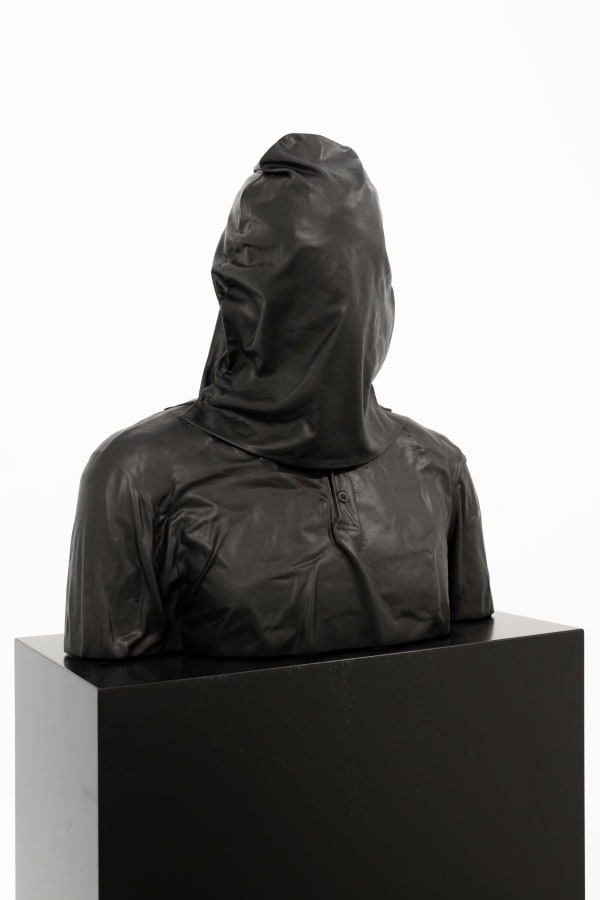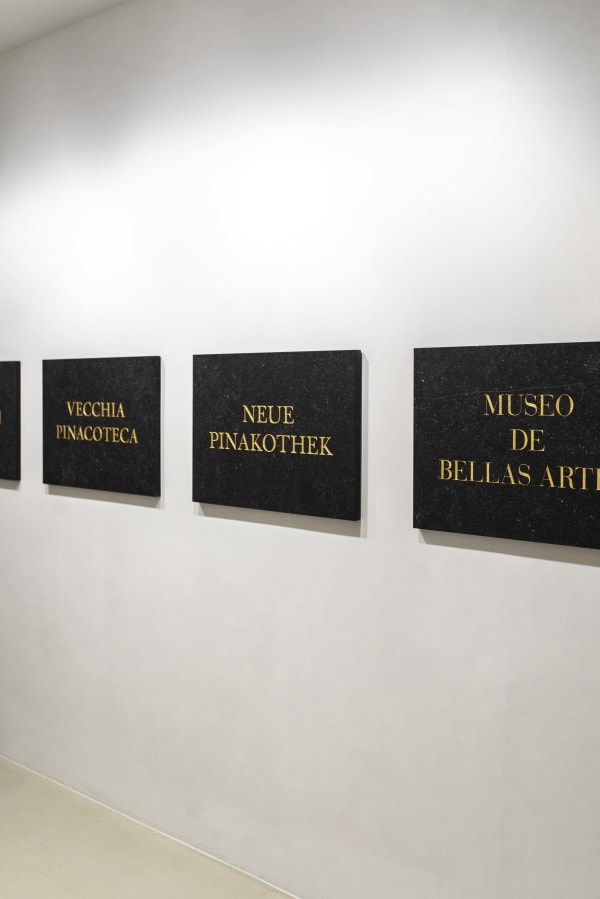leo copers: identity | identiteit | identité ...
Past exhibition
Overview
KETELEER GALLERY is very pleased to announce the first solo exhibition of Leo Copers – Identiteit (Identity) – in conjunction with the opening of the new space at Pourbusstraat 3-5, Antwerp.
Press release
The tension between beauty and horror, pretence and sincerity, death and life, science and magic are striking motives within the oeuvre of Leo Copers (°1947, Ghent). Copers gambles with the seemingly impossible and contradictory to create a magical world, a universe with its own laws and ambiguities. In his work, Copers examines the physical world, the four elements water, earth, fire and air, and tries to push the boundaries of these phenomena. But his work also has a deeply rooted politically social and even anarchist dimension. Themes like the institute of the museum or the status and persona of the artist are regularly criticised throughout his work. This last theme is also the focus of his newest solo exhibition at KETELEER Gallery, entitled Identiteit (Identity), in which a series of new and older works related to this topic are being presented.
In the new work Unselfies (since 2016), comprising – so far – one hundred framed photographs, we see the artist depicted with a black, closed hood covering his head, posing in front of the entrance of different museums and cultural institutions across the world. Copers turns the selfie culture upside down. We’re offered a vast inventory of images showcasing the proud and vain traveler in which the actual individual is unrecognisable. Is it actually the artist who’s repeatedly being portrayed?
The work also has a strong political dimension. We immediately associate the hood with the disguise of a criminal, the Ku-Klux-Klan clothing or the horrendous images of disguised hostages and terrorists. The artists emphasises that in concealing the individual’s identity, the intention of the disguise is revealed. In a sense, the concealment implies the revelation.
The very fact that Copers photographs his Unselfies at the portals of art temples shouldn’t come as a surprise. The museum was already a target of Copers’ critical approach in the past. As is the case in the work Zonder Titel (Untitled), also on view in this exhibition. The work deals with the history of the museum as an institute and consists of eleven blue stones engraved with the names of several international museums in golden letters: ‘Kunsthistorisches Museum’, ‘Museum for Moderne Kunst’ or ‘Museum for Future Art’. The artist uses different languages and different fonts referring to the historical period in which the museum in question was established. The nine plates, hung in a straight line, are accompanied by a tenth, on which only tree dots are engraved. An eleventh plate remains empty. Is this the plate that refers to the period before the birth of the museum or the period after the death of the institute?
But then the question remains: how does the artist relate to this institute?
In 1979 the artist hijacks the Museum of Fine Arts in Ghent. He mounts a pirate flag on the roof. He also visited several museums as a blind man (De Blinde Ziener (The Blind Seer, since 1977) – with dark sunglasses and a white cane – as a guerrilla action. In 2012, Copers even went so far as to place tombstones at the Citadel Parc next to S.M.A.K., Ghent, engraved with logos of different prominent Belgian and international museums. What relevance can museums still claim to have to society today? Are they mere containers for a collective memory? Or are they imploded, hollowed out institutes, in service of today’s cultural tourism and leisure economy?
But then the question remains: how does the artist relate to this institute?
In 1979 the artist hijacks the Museum of Fine Arts in Ghent. He mounts a pirate flag on the roof. He also visited several museums as a blind man (De Blinde Ziener (The Blind Seer, since 1977) – with dark sunglasses and a white cane – as a guerrilla action. In 2012, Copers even went so far as to place tombstones at the Citadel Parc next to S.M.A.K., Ghent, engraved with logos of different prominent Belgian and international museums. What relevance can museums still claim to have to society today? Are they mere containers for a collective memory? Or are they imploded, hollowed out institutes, in service of today’s cultural tourism and leisure economy?
The mystification and glorification of historically prominent or present-day popular personalities, legitimised by statues, busts or even wax statues like the ones at Madame Tussauds, are but precursors to a ‘selfie culture’ spun out of control. Both busts (2019), two identical portraits, similarly made unrecognisable with a black hood, are to be interpreted within this same context: the
artist withdraws its persona and refuses to take part in such appropriation by mass culture while simultaneously feeding into the myth of the artist by trying to reposition it.
In the late 70s, Leo Copers was already making four silk black hoods, also on view in this exhibition. One of them has an opening for the mouth and the eyes, one only for the eyes, one only for the mouth, and the last one completely closed. These hoods would later be used for several performances and public appearances. Copers claims the right to stay anonymous as an artist and creator, not revealing the mystery of the maker or his process.
Another distinct aspect is the affiliation of Leo Copers’ oeuvre with Belgian surrealism and, specifically, the work of René Magritte. The reference to Magritte’s Les Amants I and Les Amants II (1928) showing two figures with a white veil over their heads, is obvious.
As mentioned above, Copers used his hoods for various performances and video works, of which two are shown in the gallery’s basement. YRNOMLICE is a reconstruction of performance Copers did in 1980 in the former ICC in Antwerp. It shows the artist in a black costume and a black hood – with openings for the eyes and mouth – standing in front of a high table covered with a black cloth. He reads aloud from an eponymous manuscript. The text – also shown in this exhibition – is written on parchment with a golden pen in the artist’s own blood and is kept in a black silk covered binder. Despite the text’s conventional layout, the words are composed of random letters. Here too, a dialectic between mystification and demystification emerges. Every possible interpretation gets undermined. Despite the manuscript’s refined physical appearance, we sense a sinister undertone. Who brought this text forth? Why is it indecipherable? There’s an eerie atmosphere to be felt.. In many of his later works, the non-word YRNOMLICE and the blood motif keep showing as, for example, in Bloedvaandel (Blood Banner) (1979).
The second video is entitled Sociaal Kunstwerk (Social Artwork) (2010). Yet again, Leo Copers is wearing a black hood over his head. Very slowly, he drags a white banner along the ground, a symbol for peace and surrender. Tradition dictates however, that a banner or flag should never touch the ground. The title of the work stands for the way someone could become the owner of the work: solely by donation.
Copers’ provocative attitude culminates in the VIPAG (2001-2002) work, the ‘Voluntary Individual Public Automatic Prison’, the opposite of the principle of the confessional. The VIPAG is a barred cage which can be installed in public space. Passers-by can insert one euro in the lock, take a seat in the cage and get locked in for five minutes while a recorded voice speaks to them. Inside there are cameras installed and connected to the internet. The purpose is to allow people to see the prisoners from their computers at home. In 2008 the work was exhibited in front of the court of justice palace of Brussels.
This work too is telling for Leo Copers’ anarchism, his distrust in authoritarian systems and the exposure of an omnipresent hypocrisy of church and state. In Copers universe where there’s no room for the insincerity of aggrandised individualism. Here, the artist takes on the role of both witness and prosecutor.
Nadia Bijl, 2019
Installation Views
Works
-
 Leo Copers, Cilindervormige AVOG, 2003
Leo Copers, Cilindervormige AVOG, 2003 -
 Leo Copers, Borstbeeld Unselfie (Brons), 2019
Leo Copers, Borstbeeld Unselfie (Brons), 2019 -
 Leo Copers, Automatische Publieke Zit Gevangenis, 2001
Leo Copers, Automatische Publieke Zit Gevangenis, 2001 -
 Leo Copers, Automatische Vrijwillige Openbare Gevangenis II , 2000
Leo Copers, Automatische Vrijwillige Openbare Gevangenis II , 2000
-
 Leo Copers, Confrontatie, 2019
Leo Copers, Confrontatie, 2019 -
 Leo Copers, Hoods, 1979
Leo Copers, Hoods, 1979 -
 Leo Copers, Hoods, 1979-2005
Leo Copers, Hoods, 1979-2005 -
 Leo Copers, Jail (House) Rock Forever, 2001
Leo Copers, Jail (House) Rock Forever, 2001



























